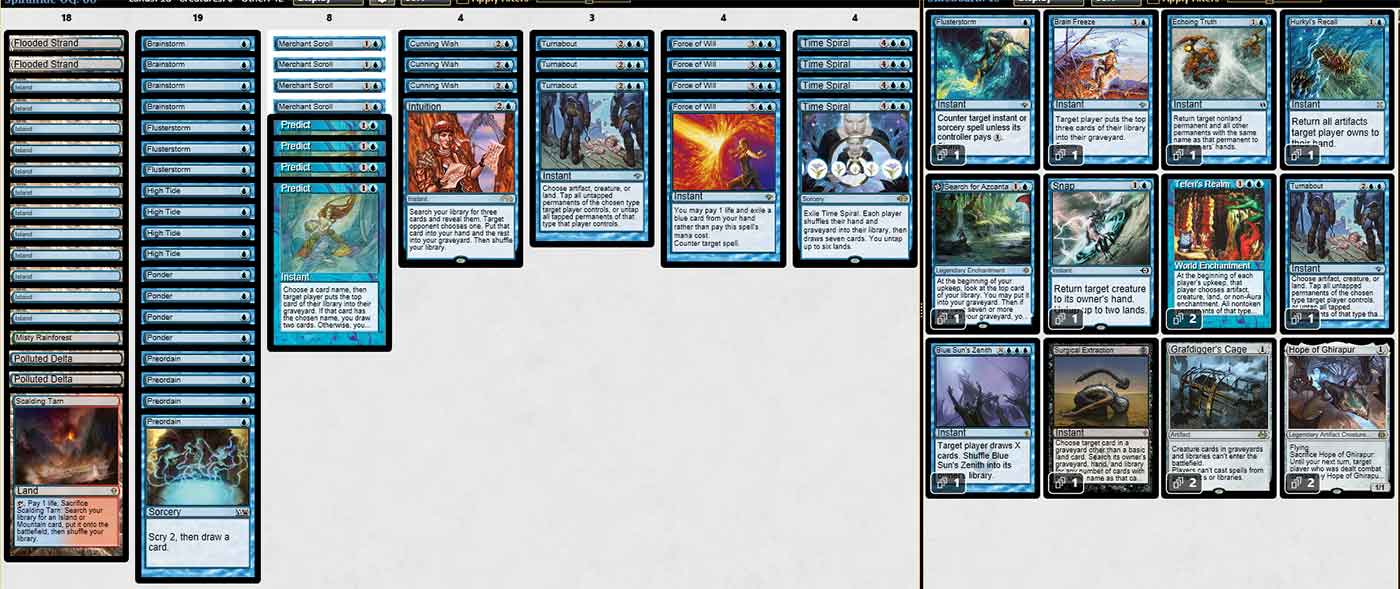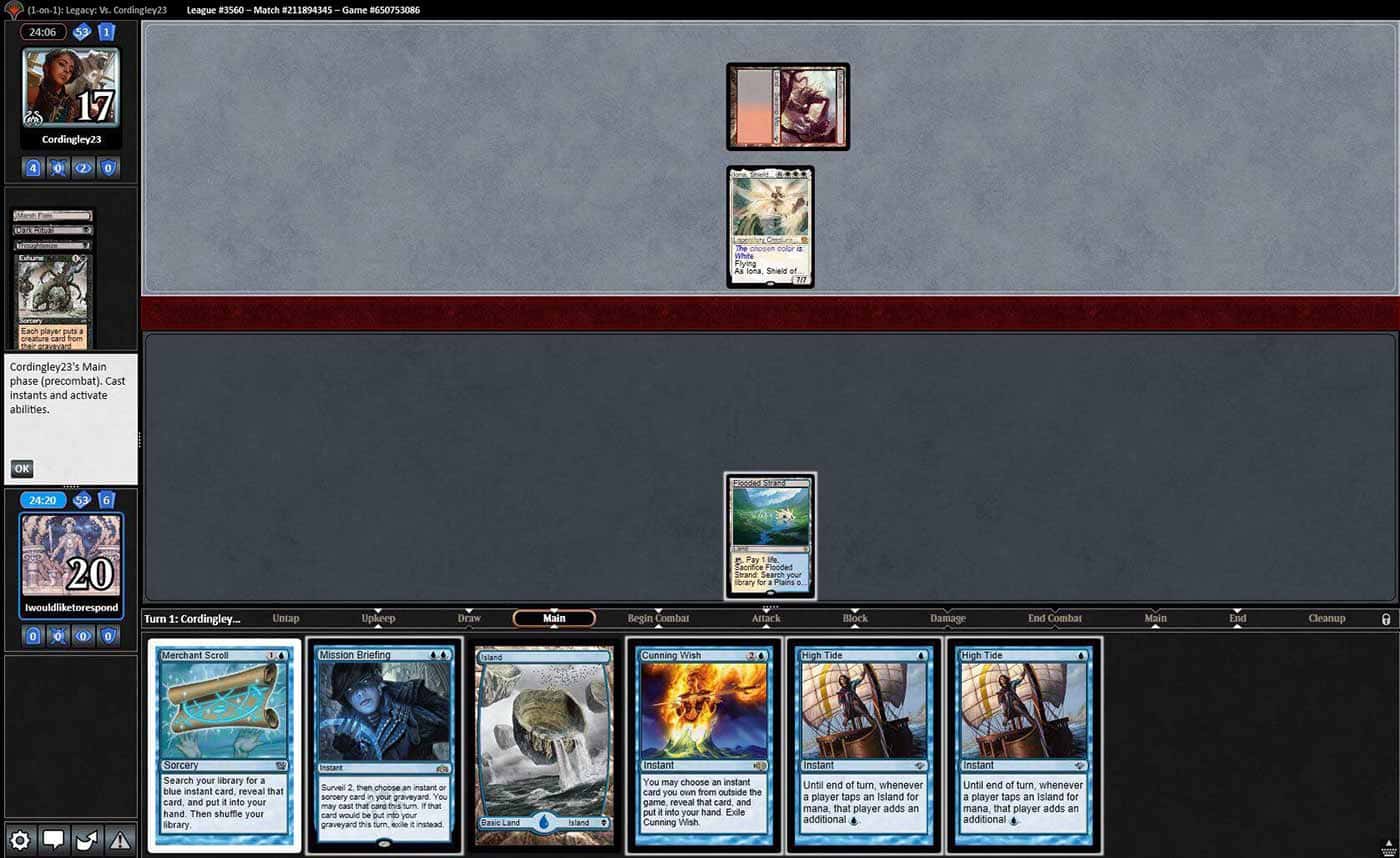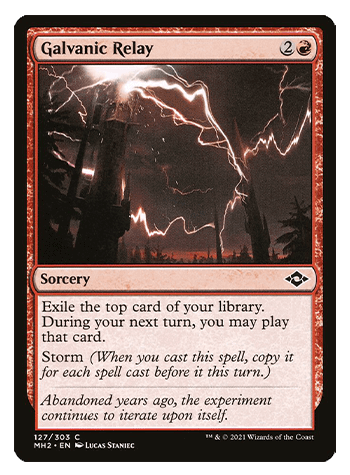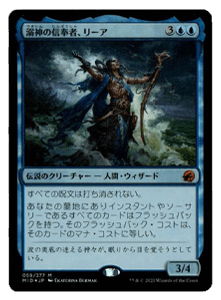My name is Marcus Ewaldh and I started playing Magic around 1995. I became a competitive player years later and started playing Legacy in 2009. It was love at first sight. I was hooked and wanted more. Sadly there is no local scene where I live so I have been putting up with MTGO and its “features” since Onslaught block under the nickname “Truckis” and more recently “Iwouldliketorespond”. I used to draft and play Standard but now I’m 100% focused on Eternal. When I build new decks people ask me “But how do you win?” which is how I know my deck is great! Decks I enjoy the most are the ones where you play every card in them. Going off with every card in your hand is not as fun as going off with every card in your deck! In Legacy, it could be High Tide variants, win-con-less Miracles, Stasis and in modern Taking Turns or Wilderness Reclamation nonsense.
Deck List
Spiral Tide
- 4 Preordain
- 4 Ponder
- 4 Brainstorm
- 4 Predict
- 4 Time Spiral
- 4 High Tide
- 4 Merchant Scroll
- 3 Cunning Wish
- 3 Turnabout
- 1 Intuition
- 2 Teferi’s Realm
- 2 Hope of Ghirapur
- 2 Grafdigger’s Cage
- 1 Snap
- 1 Surgical Extraction
- 1 Flusterstorm
- 1 Blue Sun’s Zenith
- 1 Brain Freeze
- 1 Hurkyl’s Recall
- 1 Turnabout
- 1 Flex Slot 1
- 1 Flex Slot 2
What is this deck?
In this article, I will use my “stock” list that hasn’t changed much since the banning of Sensei’s Divining Top. There are some flex slots but in general everything of strategic value in this article applies regardless of the exact decklist.
“Spiral Tide” is a mono-blue combo deck in Legacy. The name comes from the two cards “High Tide“ and “Time Spiral“ which is the duo of cards you are looking to resolve when you play this deck. High Tide is there to get more juice out of your Islands, with more mana from each copy, and Time Spiral to get a new hand but also said turbo-charged Islands untapped, ready to cast new spells. There is no win condition in the main deck so your goal is to resolve enough spells and generate enough mana and grab one with Cunning Wish. The win conditions for the deck are Brain Freeze (putting their deck in their graveyard) and Blue Sun’s Zenith (putting their deck in their hand).
There is a lot written about the history of the deck and you can check out the excellent primer written by Feline Longmore here.
Unlike its wilder cousin, “Solidarity” which pairs the card High Tide with instants only (to generate mana with the card Reset) Spiral Tide is a Sorcery speed version relying on the powerful card Time Spiral instead. It is possible to win without ever casting the card Time Spiral but it is highly unlikely, at least for my version of the deck, which is the one this article will focus on. The actual combo kill is often probabilistic but a good starting point for a win is 4 Islands in play, High Tide and Time Spiral. Turn 3 is doable but the fail-rate is significantly higher with 3 lands rather than with 4 lands or more.
Card choices
Cantrips
4 Brainstorm, 4 Ponder, 4 Preordain
Cantrips are great in Legacy. Spiral Tide is no exception to this rule. Cantrips lets us get away with playing fewer actual lands, help us dig for combo-pieces/protection and smooth out our draw steps. They also let us plan ahead, setting up a combo turn without exposing a critical piece to discard by “floating” it on top of the deck, or set up Predict. Cantrips are also crucial combo-pieces making sure you can keep going off while also adding to the storm-count.
Tutors
4 Merchant Scroll, 3 Cunning Wish, 1 Intuition
Merchant Scroll is basically a Demonic Tutor in this deck (with Time Spiral being the only big exception). The most common targets are Force of Will, High Tide or sideboard cards in post-board games. Intuition is great for the “goldfish” as it’s one of the few ways in Legacy to tutor for a Time Spiral. It’s a one-of but you can find it with a Merchant Scroll and set up a pretty consistent turn 4 kill. It’s also a nice card to have when you have the combo in hand already but just need another turn to make a land drop. If your opponent casts a discard spell you can now Intuition for the missing piece. Cunning Wish is a unique card in the sense that it can be almost anything, even in pre sideboard games. Some combo decks struggle with cards like Gaddock Teeg, Chalice of the Void or Force of Will. Spiral Tide can, slowly but steadily, dig out of almost any situation using Cunning Wish to find an answer to most problems. It also doubles up as a win-condition without diluting the main deck with highly situational cards.
Mana base
12 Island, 2 Polluted Delta, 2 Flooded Strand, 1 Scalding Tarn, 1 Misty Rainforest
18 lands total with 12 Islands and 6 Fetchlands has been the standard for as long as I have been playing the deck. The purpose of Fetchlands in this deck is to maximize the utility of Ponder and Brainstorm providing a shuffle effect when needed. Splitting up the Fetchlands is just to play around Pithing Needle and Sorcerous Spyglass.
Mana generators
These are the combo pieces of the deck, the enablers if you will. Turnabout is the weakest combo-enabler but also has some utility outside of being a combo-piece tapping down creatures and lands for the opponent. In order to maximize the mana when “combo-ing” you want a balance between the two and strive for casting all the High Tides before Turnabout to untap your lands, to net the maximum amount of mana. To “go off” with High Tide you need a total of 4 Islands and a Time Spiral. For Turnabout, you need 5 and a Time Spiral. This is a desperate move and will not net any extra mana post-spiral.
Bombs
One of the most powerful cards in all of Legacy and the pay-off combo-piece in the deck. Free cards and free mana, breaking the fundamental rules of a game of Magic.
Protection
4 Force of Will, 3 Flusterstorm
Force of Will and Flusterstorm helps with both staying alive, slowing the game down and to resolve key spells.
Utility
4 Predict
Some lists play main deck win conditions or bounce-spells for troublesome permanents but personally, I believe in keeping things simple, focused, and just have more of it all instead. I chose to Predict to fill this role because it’s one of the most efficient ways to, with a low risk, generate actual card advantage.
Why should you play this deck?
The deck sees surprisingly little play and I don’t really know why. A common misunderstanding is that you need to spend an arm and a leg to buy a playset of Candelabra of Tawnos only to end up with a slower, durdlier and worse version of Show and Tell. This is wrong and I hope my article can sort out the confusion and help me spread the joy that is tapping Islands for lots of mana. Spiral tide is not only better than people give it credit for, but my version is also one of the cheapest decks in all of Legacy!
It is true that Spiral Tide share a lot of cards with Show and Tell and on average it is about a turn slower, in fact, Spiral Tide is one of the slowest combo decks in all of Legacy. This is not a huge concern as it’s often fast enough for any kind of “fair” matchup while at the same time have enough tools to control the faster decks of the format or the lock-pieces that people throw at you. Why be fast if you are fast enough? The appeal to the deck is that more often than not you, not variance nor the opponent, are responsible for the outcome of the game. With so many ways to find specific cards and a rock solid mana base variance is kept at a minimum. With this deck, you basically keep every hand you are dealt with. There is pretty much always a solution to any situation, given enough time. Instead of thinking about Spiral Tide as a slow combo deck think about it as a control deck like Miracles with a combo finish.
In doing just that it became apparent to me that I should focus on grinding the disruptive decks rather than trying out-race them, playing control during the setup stage and the switch to combo once I am ready to win. Play to the strength of my deck. Playing games I started to prioritize making land drops, card draw and countermagic over cards with the single purpose of only adding more mana once I am going off the combo pieces. Multiple copies of High Tide and untap effects like Cards like Candelabra of Tawnos and Turnabout makes things easier when going off, especially for the Blue Sun’s Zenith Kill, but I found that more often than not it’s about resolving Time Spiral, not about how much mana I have available when I do. I want access to this type of untap-effect in the deck, but it should be kept to a minimum to instead maximize the chances of going off in the first place. In this deck, it’s not worth to have a card that is only good once you are already “winning”. This is even truer in the post-board games when your opponent most likely gets a deck with a higher density of relevant cards and you no longer can go off and “steal a win” when their hand had Fatal Push, Abrupt Decay and True-Name Nemesis in it.
The untap-effects are the most common card to sideboard out. I have tried different numbers of untap-effects and different mixes of Turnabout/Candelabra of Tawnos but since they’re more a necessary evil than something I really want I am firmly in the Turnabout camp, which has a higher floor than Candelabra of Tawnos. Turnabout can be pitched to Force of Will and can also be cast to tap down either lands or creatures from the opponent. On its own Candelabra of Tawnos does nothing and it even opens up more disruption to become relevant against us. Phyrexian Revoker, Stifle, Abrupt Decay (although you can hold on the Candelabras until you have resolved High Tide) just to name few. Candelabra of Tawnos has some things going for it, it’s still a decent card. It’s better than Turnabout playing around soft-Counterspells like Daze and Spell Pierce and it can be bounced to generate mana.
Once I figured out how few of the untap effects I could get away with I spent these slots cementing the role as a control deck with additional card draw in the form of Predict. If the metagame calls for pure speed then a version with Candelabra of Tawnos alongside Turnabout is better but in a metagame like that there are a lot better options than Spiral Tide, like TES.
Playing the deck
Playing Spiral Tide, you want to prolong the game to decrease the fail-rate of Time Spiral (drawing only lands or not having enough mana post Spiral). You often can prolong the game between all the countermagic and bounce spells that the deck offers. I often rule out a quick combo-kill unless I am super scared of what my opponent can do next turn. If they are tapped out and you have double High Tide+Turnabout+Time Spiral then, by all means, go for it. Spiral tide can kill on turn 3 but it is unlikely. The slower and less interactive deck you face (Nic Fit) the more combo-pieces you can afford to have. On the other hand, if your opponent is playing a fast deck with disruption (like ANT) you instead focus on finding enough layers of protection. As long as you don’t die, you’ll win eventually. Being able to play both control and combo means that you have to re-evaluate your position every turn and cantrip or tutor accordingly. Remember that High Tide still adds extra mana to any Island you play after High Tide resolves, so it’s often fine to go High Tide–Turnabout–Time Spiral with 3 Islands in play with a land drop still available post-Spiral. Be warned, however, your opponent will get a new hand too. High Tide is symmetrical, so you have to consider how much interaction you should respect from your opponent when you sculpt your hand post-spiral. It is crucial to remember which cards you should play around, most blue decks will have some kind of countermagic but even the non-blue ones could sometimes interact with Mindbreak Trap, Surgical Extraction, Aven Mindcensor, or Pyroblast, just to name a few.
Cantripping/Tutoring
One both very difficult and also a very rewarding part of the deck is to know how to cantrip. Sequencing your Ponder/Preordain/Brainstorm and Predict is crucial in order to maximize your chances of winning and finding answers to problems at hand or potential problems a few turns later. When cantripping you prioritize making land drops but after that, it’s very matchup dependent. In some matchups, it’s more a race than anything. For example, vs Elves, Burn, etc. I want exactly one Force of Will for Natural Order/Eidolon of the Great Revel but beyond that, I just want to be fast and my cantripping and tutoring should reflect that. These matchups are often determined by who won the die-roll so speed is extremely important here. You want to spend all your mana every single turn so even something unholy as casting Brainstorm turn 1 is sometimes the correct play. Unlike some other combo decks, High Tide is always at least a turn 3 deck and can’t go off turn 1-2 with a flurry of rituals, for example. You have to be patient and make those land drops and dig for additional copies of combo pieces rather than setting up more card draw with Predict.
In other matchups, most of them actually, you instead focus on not going off at all and instead dictate the pace of the game and “stumble into a win”. Cantripping here should instead focus on playing around discard spells and setting up Predict. This control role is cemented even further in some post-board games where you have very few actual combo pieces left in the deck. A typical post-board configuration versus a combo deck consists of 3 High Tide and 1 Turnabout as the only non-disruptive, non-card-neutral cards left in the deck! So not only do you maximize your chances of actual card advantage with Predict, you want to keep up the virtual card advantage by minimizing the number of irrelevant cards (AKA combo pieces). Compare this rate to a deck like Show and Tell where maybe a third of your deck are strictly combo-pieces and you often end up drawing multiple copies of combo-piece A when all you need is a B. A deck like TES could also suffer from this issue when over half the deck is mana, and all you need is a pay-off spell like Burning Wish. Instead of drawing a blank in the mid/late-game the theory behind my version of Spiral Tide is that you draw something that down the line will transform into the exact card I am looking for, or even more! The late game often favors Spiral Tide regardless of the matchup. The longer you wait for the more layers of protection you can add with more countermagic, more mana to pay for Daze etc. More cards means more resources but that’s not all of it, most decks in Legacy are not well-equipped to take advantage of the late game as well as Spiral Tide. Even if you are not up on actual cards the virtual card advantage gained from your opponent drawing cards they can’t really use or have mana they have nothing to cast, adds up to your win percentage.
Spiral Tide can also gain a tempo advantage. From turn 4 and forward your opponent lives in constant fear of you going off the very next turn and to respect that they need to pass their turn with mana up, mana that they instead could’ve used to advance their own game plan. Taking advantage of this situation at their end step by casting Predict to pull ahead on cards or cast Cunning Wish for that missing piece puts them in an awkward position. If they interact now they will be spending mana and if they don’t you will resolve your spells, advancing your game plan at a very low risk. If you have the time you do this song and dance until you are ready to go off and then set up the kill with an end of turn Turnabout to tap their lands. This will force the issue on their behalf, without exposing your combo pieces in a counter-war. This is particularly relevant in matchups where cards like Pyroblast and Flusterstorm sees play. Cards like these are very effective against a strategy of trying to resolve an expensive 6 mana spell during your main phase. Tapping their lands in their end step means that they are unable to cast those spells when you go off, both pre and post-Time Spiral. Once Turnabout resolves you only need to worry about Force of Will, Daze, Surgical Extraction, Mindbreak Trap and maybe some fringe card I haven’t heard about.
So now it is clear that unlike other, more linear and explosive combo decks, Spiral Tide benefits greatly from being patient. Not only that but it’s also punished more than other combo decks for failing at going off. When you go off you are likely to commit more resources than your opponent is for answering your attempt. If your opponent has a Counterspell and you commit High Tide (or sometimes multiple copies!) + Time Spiral into the exchange you might not be able to set up a kill again anytime soon. This is a big downside compared to other 2-card combos like Painter’s Servant/Grindstone or Show and Tell/Griselbrand where they can just jam another copy the following turn. On the flip side, there are very few cards that can actually punish us from not going off. You don’t care about wasteland and you can often Counterspell/bounce anything that the opponent can top-deck.
The kill
Brain Freeze is the easiest and most common way to win but it’s not always enough. Sometimes your opponent’s deck simply will not be emptied regardless of how many copies of Brain Freeze you put on the stack. Versus decks with Emrakul, the Aeons Torn, Progenitus, Blightsteel Colossus or other shuffle effects you need something else. To kill your opponent right away you can cast Blue Sun’s Zenith for their deck and some, or use a combination of Brain Freeze + Blue Sun’s Zenith (although this option is a bit shaky) or you can Cunning Wish->Surgical Extraction the card with a shuffle trigger with an excess number of Brain Freeze copies on the stack, though this last one doesn’t beat Blightsteel Colossus/Progenitus. A Blue Sun’s Zenith kill in general requires 5 lands or multiple Time Spirals. There’s always a small risk of fizzling with Spiral or that your opponent draws enough countermagic to stop you.
Sideboarding
In the main deck, there are not a lot of situational, potentially worthless, cards for a specific matchup. Even the few that exist and have no use can be Predicted away, Brainstormed back in the deck or pitched to a Force of Will. The floor of each component in the main deck is very high. For sideboarding purposes, this means that we don’t need to bring a lot of cards for any matchup to fill a void of unplayable cards. This is perfect for Spiral Tide because there are not many sideboard slots left outside the Cunning Wish-board. In my list I have between 6-7 slots to help against a certain type of troublesome angles of attack, the rest are cards I want to be able to find with a Cunning Wish. In some matchups I sideboard in one of these Cunning Wish-targets so that I have access to a similar effect from both Cunning Wish and Merchant Scroll.
A wish-board can be highly customized to fit an expected metagame. One of the traps when building one is to include “cute” answers to very rare scenarios. For each slot, there has to be a well-defined purpose and a sideboard map that works out. With a deck with a floor, this high over-sideboarding, in particular, is a bad idea. The benefit of a sideboard card is not just the power-level in a vacuum but the difference between it and the card that was cut.
I have divided post-board strategy in four categories, Prison, Control, Tempo, and Combo. Legacy has a great number of decks and you need to adjust your game plan and sideboard accordingly but a good starting point is to think in terms of these four categories.
Before I start on the categories there is one, Phyrexian mana cost, sideboard card that you could expect out of many different decks, Surgical Extraction. To deal with this I always sideboard out one copy of High Tide so that if High Tide gets hit by Surgical Extraction from the deck I can still use Cunning Wish to find it from the Sideboard. This is particularly important versus black decks where they can pair Surgical Extraction with a card like Duress. Another way to deal with Surgical Extraction is patience. Don’t expose critical combo pieces and prolong the attempt to go off as much as possible, minimizing the risk of being choked on a critical combo piece or mana. One High Tide is usually enough for a Brain Freeze kill and sometimes, with enough lands, you don’t even need that first copy (but it’s a lot better if you do have it).
Playing around Surgical Extraction also means that you, unfortunately, have to sideboard out the one copy of Intuition.
2 Teferi’s Realm – Permanent based hate
2 Hope of Ghirapur – Stack based hate
2 Grafdigger’s Cage – Graveyard based hate
Wishboard
1 Snap
1 Surgical Extraction
1 Flusterstorm
1 Blue Sun’s Zenith
1 Brain Freeze
1 Hurkyl’s Recall
1 Turnabout
1 Echoing Truth
1 Flex slot
Against Prison
Prison decks primarily look to resolve permanents that either makes it tough or impossible for you to “go off”. Eldrazi is a rough matchup since it not only has lock-pieces like Chalice of the Void but also a fast clock. Aggro Loam is fine and Moon Stompy/Death & Taxes are favored. The reason for the difference is that given enough time you will dig out of pretty much any lock, and Eldrazi has historically been the fastest of the Prison matchups. Basic Islands goes a long way to play around cards like Blood Moon and Wasteland when you need to bide your time. Eventually, you will find Merchant Scroll for Cunning Wish for Hurkyl’s Recall is a slow but super-consistent route to go from 10/90 to win the matchup to 90/10 in one turn. Even sphere effects can be ignored given enough lands/High Tides. So it’s mostly about not dying rather than not losing to hate cards. Post-board, Teferi’s Realm is a truly amazing card to deal with prison elements, artifacts or creatures. It’s one of the few ways to deal with a board of Mother of Runes, Thalia, Guardian of Thraben, Ethersworn Canonist, Sanctum Prelate, and Gaddock Teeg. Or a board of Trinisphere, Sphere of Resistance and Chalice of the Void. Also of note, these decks have very little card-advantage/clock so once you turn the corners you will set them back somewhere in the region of 5 turns on the back of a single Teferi’s Realm.
Sideboarding is pretty straight forward, you cut all the Flusterstorms and a High Tide for 2 Teferi’s Realm, Snap and a Hurkyl’s Recall (leaving the Echoing Truth in the sideboard so you can either scroll or wish for an answer to Chalice of the Void).
Against Control
Control decks Often times have a very slow actual clock and instead looks to trade resources and pull ahead on cards. Sometimes they have permanent-based hate but more often than not the stack is where the outcome of a game is decided. Pre-board games are often heavily favored for Spiral Tide because of the high number of creature removal spells and such that will rot in your opponent’s hand. Try to go off with 5-6 lands in play and a full hand. If you have the option to tap them out with Turnabout you probably should minimize the risk of them being able to cast any of the spells they draw from their Time Spiral hand. To play around top-decked discard spells, Counterbalance, etc. you can Turnabout in their upkeep but then they have the option to make a land drop and cast spells (note how High Tide is symmetrical and one Island will represent 2 mana for a Counterspell post-tide). If they ever cast a spell and have mana left in their mana pool try to switch phases and empty their pool if possible.
Post-board will more difficult. It’s important to identify which clock you are afraid of; Snapcaster Mages are often something you should ignore but a Monastery Mentor can get out of hand quickly. Some of these permanents you either need to combo in 1-2 turns to beat or answer it on the stack. Mentor aside, the clock you are worried about is actually outside of the red-zone and it’s more a race to finding lock pieces. You don’t want them to resolve Leovold, Emissary of Trest, Counterbalance or Jace, the Mind Sculptor and depending on your hand you might have to take some risks just so that you don’t have to deal with those cards. Mono-blue has very little to offer in profitable ways of dealing with these kinds of permanents once they resolve. If for example Jace, the Mind Sculptor slips through AND you can’t kill them the following turn it’s very likely that you will never be able to once they have access to a free Brainstorm every turn. Again, prioritize card draw and countermagic and “never” prioritize looking for combo-pieces. Often times these will end up in your hand after a random draw step or a shuffle from a Ponder.
For sideboarding, you have access to Hope of Girapur as a plan completely side-step the issue with counter-magic. One High Tide and the single copy of Intuition should be sided out and to make space for additional sideboard cards you cut Turnabout. You want the densest deck possible and cutting all but one Turnabout (as a Merchant Scroll target) is the best way to achieve that. For most “fair” blue matchups I like to sideboard in the copy of Flusterstorm.
Against Tempo
Tempo decks require very few resources to operate and try to capitalize on this advantage by ending the game before Spiral Tide has time to set up. This is a tough matchup for Spiral Tide. You have to play the guessing game on how many turns you have before you die and something like a Lightning Bolt or an extra elemental token from a Young Pyromancer can change that before you have time to adapt. Add the fact that these decks also have access to both discard spells and countermagic and you are in for a challenge. There are tools in the form of Hope of Ghirapur etc to turn the dynamics upside down but these can go from stellar to useless depending on the board state. You have to evaluate your hand and play to its strength. Sometimes it’s correct to Force of Will their Delver of Secrets and Flusterstorm their Ponder. If you have a very slow but Predict-heavy hand all you need is to trade 1 for 1 until you set up. Being under no pressure lets us play around taxing countermagic more freely, too.
Sideboard the same way as versus to Control decks.
Against Combo
Combo decks can come in many shapes and forms, some are slow and highly disruptive and some are fast with no disruption at all. Spiral tide approach combo generally the same way regardless of taking the role as the Control deck. Sideboarding is about the same as versus control but the gameplay is a bit easier since you don’t need to focus on keeping up on cards as much. As long as you have not lost you are probably winning. Combo decks, in general, have no ways to gain card advantage. Accumulated Knowledge and Faithless Looting require a very different amount of resolved Predict to fight through. Flusterstorm is a priority regardless, and graveyard hate in some cases. The sideboard can vary but the first cuts from the main deck are often combo pieces.
Wrap-up
Spiral Tide is one of the most fun (according to me and… hopefully someone else!) and also misunderstood decks in Legacy. It is a good choice for a tournament and I hope that this article was helpful and interesting and that we see more Spiral Tide at the top tables. Being under the radar has been great so far but I am willing to give up percentages if it means that more people enjoy the deck. The picture below is an example of what under-the-radar means.





















